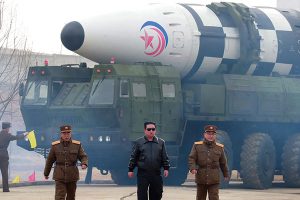Bloomberg
Kim Jong-un oversaw the successful launch of a new, larger intercontinental ballistic missile (ICBM), in an explosive confirmation of his continued nuclear weapons development over the past four years despite international sanctions and failed talks with the US.
The missile fired from a mobile launcher at Pyongyang Sunan International Airport was a Hwasong-17, according to dispatches and photographs published by the official Korean Central News Agency. Kim toured the launch site and shouted “Fire!†before the rocket flew to an altitude of 6,200 kilometres (3,900 miles) and fell 1,090 kilometers away in waters off Japan, KCNA said.
It was North Korea’s first successful ICBM test since November 2017, a milestone that prompted speculation of a strike by the US and United Nations sanctions that are still stifling the country’s economy. The Hwasong-17, the world’s largest road-mobile ICBM, was unveiled in October 2020 and is believed to be capable of carrying multiple nuclear warheads across the Pacific Ocean.
Kim said North Korea must be ready for “long-standing confrontation with the US†and warned that outside forces would face a “very dear price†for attempts to infringe on the country’s security. “He affirmed that the strategic forces of the DPRK are fully ready to thoroughly curb and contain any dangerous military attempts of the US imperialists,†KCNA said, referring to North Korea’s formal name.
US President Joe Biden, South Korea’s Moon Jae-in and Japanese Prime Minister Fumio Kishida condemned the launch, which is a violation of United Nations resolutions banning ballistic missile tests by North Korea. Biden and Kishida “strongly condemned†the launch, North Korea’s first test of such a weapon in more than four years, “stressed the need for diplomacy, and agreed to continue working together to hold the DPRK accountable,†the White House said in a statement.
The launch represented Kim’s abandonment of a testing freeze that had underpinned an unprecedented wave of talks with President Donald Trump, who declared at the time that North Korea was “no longer a nuclear threat.†Those talks unraveled in February 2019 after Trump rejected Kim’s demands for sanctions relief in exchange for a dismantling some nuclear
facilities during a summit in Hanoi. Kim later resumed weapons tests and has so far rebuffed Biden’s overtures to resume dialogue.
The UN Security Council was expected to discuss the launch during a meeting Friday in New York, where China and Russia stand as possible opponents to any effort to punish Kim. While the two veto-wielding Security Council members supported crippling sanctions on the country in 2017, they’re less likely to do so now as they oppose the US-led campaign against Russia’s invasion of Ukraine.
China Foreign Ministry spokesman Wang Wenbin called for restraint, without criticising North Korea. “We hope that all parties can keep in mind the big picture of peace and stability of the peninsula, stick to the right direction of dialogue and consultation, and work together for the political settle of the peninsula issue,†he told a regular news briefing in Beijing.
North Korea has ramped up activity at key missile and nuclear weapons sites since signaling in January that it might end the testing freeze. The country also appears to be undertaking construction work at its main nuclear weapons test site for the first time in about four years.
The launch comes as a more hawkish president-elect, Yoon Suk Yeol, prepares to take power in Seoul on a promise to strengthen ties with Washington and take a tougher line against Pyongyang. Kim is also believed to be preparing a massive military parade to mark the 100th anniversary of his grandfather — state founder Kim Il Sung — on April 15, an event North Korea has often used to unveil new military hardware.
“North Korea wanted to send a message that it’s not going to be intimidated by a more hardline government in South Korea,†said James Kim, a senior research fellow at Asan Institute for Policy Studies in Seoul.
 The Gulf Time Newspaper One of the finest business newspapers in the UAE brought to you by our professional writers and editors.
The Gulf Time Newspaper One of the finest business newspapers in the UAE brought to you by our professional writers and editors.
